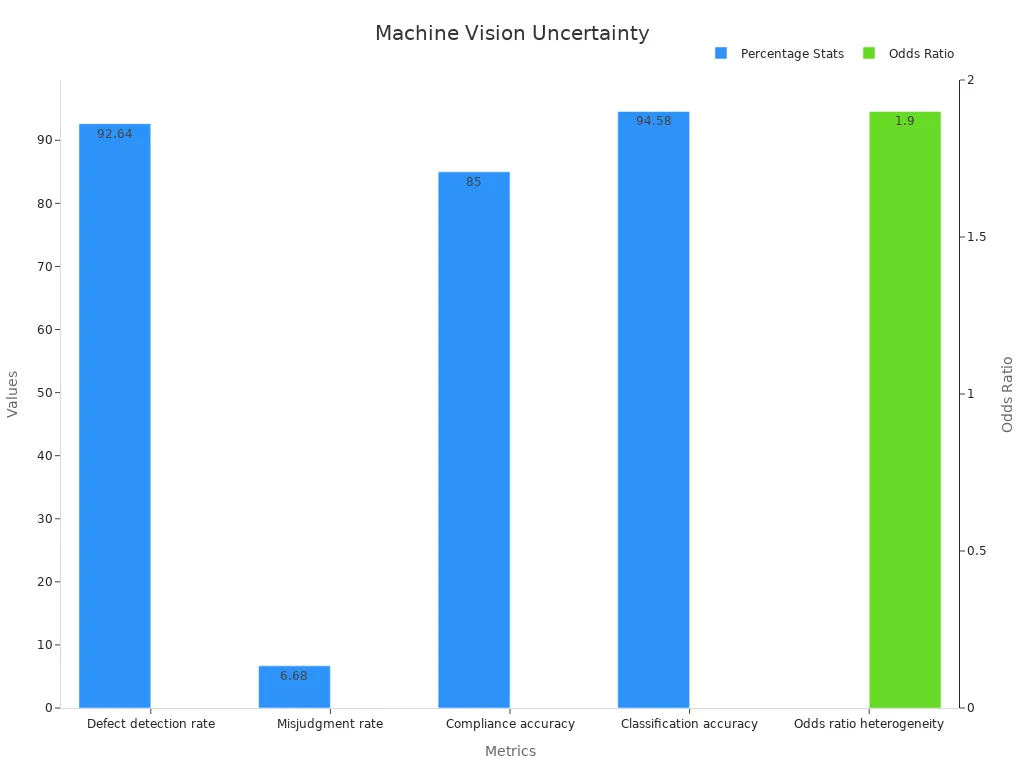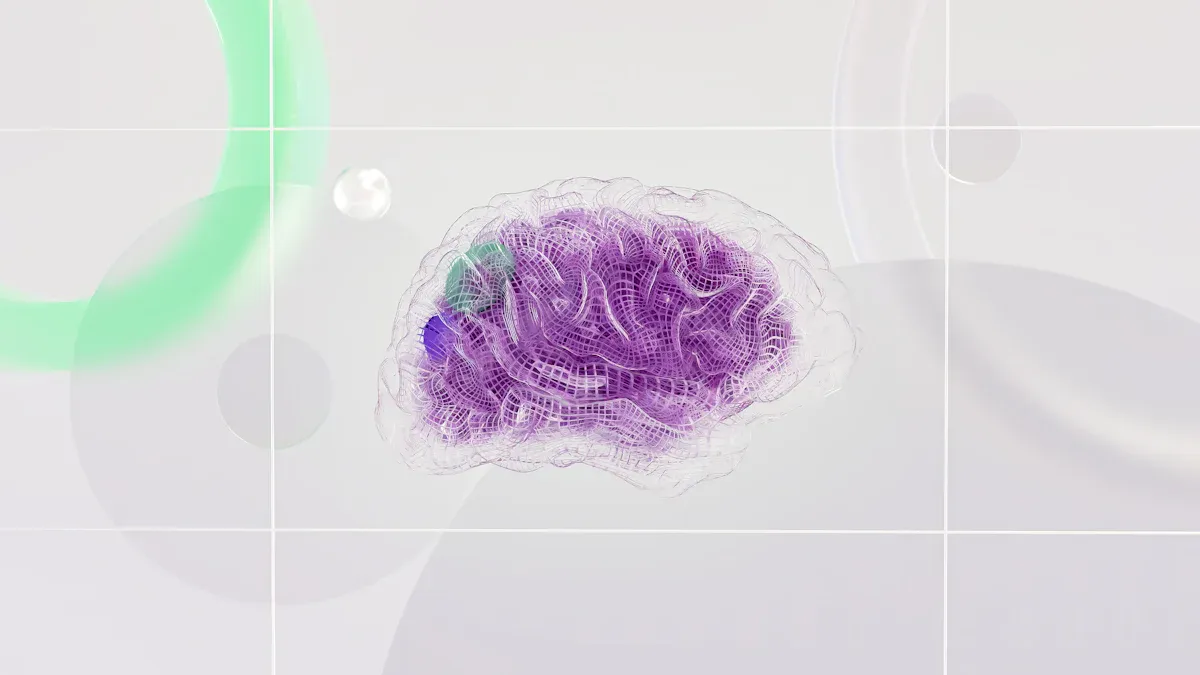
What happens when a machine vision system achieves 92.64% defect detection yet still faces a 6.68% misjudgment rate? Uncertainty remains a critical challenge. Professionals see confidence intervals and confidence interval metrics shape real-time decisions, while businesses navigate a 3.9% market decline and a projected rebound to $23.06 billion in 2025.

Every uncertainty machine vision system must address confidence interval trade-offs, ensure reliable performance, and interpret confidence intervals for actionable insights. Confidence intervals quantify risk, guide investments, and enhance trust in every machine vision system deployment.
Key Takeaways
- Uncertainty in machine vision comes mainly from data noise, model limits, and environmental changes like lighting and camera angles.
- Measuring uncertainty with confidence intervals helps teams trust predictions and make better decisions in object detection and face recognition.
- New methods in 2025 use Bayesian deep learning and ensemble models to improve how machines estimate and manage uncertainty.
- Proper uncertainty quantification reduces errors, improves reliability, and supports safer real-world applications like healthcare and autonomous vehicles.
- Teams should use clear uncertainty measures and best practices to build more accurate and trustworthy machine vision systems.
Uncertainty Machine Vision System: Main Sources
Data and Model Uncertainty
Uncertainty in computer vision arises from two main sources: data and model limitations. Aleatoric uncertainty comes from random noise in the data, such as sensor errors or natural variability. For example, in object detection, measurement errors or incomplete data can cause the machine vision system to misclassify objects. This type of uncertainty remains even if engineers collect more data. Epistemic uncertainty, on the other hand, results from gaps in the model’s knowledge or assumptions. In face recognition, a model trained on limited faces may struggle with new identities, leading to higher uncertainty in object detection and face recognition tasks. Researchers use techniques like Bayesian neural networks and Monte Carlo dropout to estimate these uncertainties. Removing pixels with high uncertainty in image segmentation improves accuracy, showing how uncertainty quantification directly impacts machine vision system performance. Confidence intervals help quantify the reliability of predictions, guiding decisions in both object detection and face recognition. In practice, uncertainty quantification and confidence intervals allow teams to measure and manage risk, ensuring that the uncertainty machine vision system delivers trustworthy results.
Environmental Factors
Environmental factors introduce another layer of uncertainty in computer vision. Lighting changes, camera angle, and sensor quality all affect the accuracy of object detection and face recognition. For instance, poor illumination or occlusion can increase uncertainty in object detection, making it harder for the machine vision system to identify objects or faces correctly. Studies show that using fill lights or adjusting camera parameters can reduce uncertainty in computer vision tasks. In face recognition, environmental changes like shadows or reflections can lead to higher uncertainty, impacting the confidence interval of each prediction. System parameters, such as optics and calibration, also play a role. Traceability to SI units and careful measurement uncertainty help maintain reliability. Confidence intervals and uncertainty measures provide a way to assess how much trust to place in each result. By understanding and managing these environmental sources, professionals can improve the performance of every uncertainty machine vision system, especially in real-world object detection and face recognition scenarios.
Uncertainty in Computer Vision: Impact on Performance
Accuracy and Reliability
Uncertainty in computer vision directly affects the accuracy and reliability of every machine vision system. When engineers evaluate object detection or face recognition, they must consider how uncertainty in object detection and uncertainty in face recognition influence the results. Uncertainty-aware computer vision models use advanced techniques to estimate and manage these risks. For example, Bayesian deep learning and ensemble methods help quantify uncertainty in computer vision, leading to more reliable predictions. Dropout as a Bayesian approximation and Hamiltonian Monte Carlo further enhance uncertainty estimation. Accurate uncertainty quantification improves model performance evaluation and supports trustworthy machine vision systems.
Studies show that uncertainty in computer vision impacts reliability. For instance, a measurement uncertainty model for computer vision-based structural dynamic displacement monitoring demonstrated that measurement errors usually stayed below 1%, with only rare cases exceeding 2.03%. Both hardware and software choices, such as camera resolution and algorithm selection, play a role in uncertainty in object detection and uncertainty in face recognition. These factors guide evaluation and model performance evaluation, ensuring that confidence intervals reflect true system capability.
| Aspect | Description | Quantitative Result |
|---|---|---|
| Measurement Uncertainty Model | Developed for CV-based structural dynamic displacement monitoring (CV-SDDM) | – |
| Experimental Validation | Bridge shaker experiment validating uncertainty bounds | Errors exceeded bounds at most 2.03%, usually <1% |
| Hardware Influence | Effects of camera resolution, lens focal length, and other parameters | Practical guidelines for optimizing accuracy |
| Software Influence | Impact of algorithms on measurement uncertainty | – |
Real-World Consequences
Uncertainty in computer vision has real-world consequences for object detection, face recognition, and automated tasks. In digital histopathology, deep learning models use uncertainty thresholds to separate high- and low-confidence predictions. High-confidence predictions in object detection and face recognition consistently outperform those without uncertainty consideration. However, when models face domain shifts, such as new data types, uncertainty in object detection and uncertainty in face recognition increase, leading to misclassification risks. This affects decision-making in machine vision and can impact patient safety in clinical settings.
Uncertainty propagation influences measurement outcomes. If a machine vision system underestimates uncertainty in object detection or uncertainty in face recognition, it may produce unreliable results. Evaluation and model performance evaluation must account for these risks. Confidence intervals and uncertainty-aware computer vision approaches help teams manage risk and maintain confidence in every machine vision system. By understanding uncertainty in computer vision, professionals can build more robust and reliable solutions for object detection and face recognition.
Confidence Interval Machine Vision System: Advances in 2025

Quantifying Uncertainty
A confidence interval machine vision system in 2025 uses confidence intervals to measure how certain a prediction is. Confidence intervals show the range where the true value likely falls. This helps teams understand the risk in each prediction. In a machine vision system, confidence intervals support better decisions by showing how much trust to place in results. Uncertainty quantification uses these intervals to give a clear picture of prediction reliability.
Recent advances have made uncertainty quantification faster and more accurate. Scalable Bayesian inference algorithms, such as variational inference with normalizing flows and Newtonian Monte Carlo, now allow complex models to use confidence intervals in real time. Bayesian deep learning, including Bayesian CNNs and neural networks, provides confidence intervals for medical image classification. This reduces overconfident mistakes. In autonomous vehicles, Bayesian sensor fusion and neural networks with MC dropout use confidence intervals to improve obstacle detection. Companies like Waymo and Bayesian Health have adopted these methods, showing industry trust in confidence interval machine vision system solutions.
Uncertainty quantification also uses error-based calibration plots, Spearman’s rank correlation, and negative log likelihood to check how well confidence intervals match real outcomes. These metrics help teams choose the best confidence interval machine vision system for their needs.
- Confidence intervals guide risk management in every uncertainty-aware computer vision project.
- Confidence intervals help teams compare models and select the most reliable machine vision system.
- Confidence intervals support regulatory approval by providing clear uncertainty quantification.
New Methods and Best Practices
New methods in 2025 have improved how a confidence interval machine vision system handles uncertainty. Bayesian deep learning, Monte Carlo simulation, and probabilistic modeling all play key roles. Ensemble methods, such as deep ensembles and bootstrapping, combine several models to create more accurate confidence intervals. These methods balance speed and accuracy, making them popular for uncertainty quantification in real-world tasks.
Best practices now include using calibration techniques like Platt scaling and temperature scaling to make confidence intervals more reliable. Teams use automated neural architecture search with deep ensembles to find the best models for uncertainty quantification. In healthcare, finance, and autonomous vehicles, confidence intervals help detect outliers and improve decision-making.
Practical guidelines suggest that teams should:
- Choose the right uncertainty quantification method for each machine vision system.
- Use confidence intervals to communicate uncertainty clearly to stakeholders.
- Evaluate confidence intervals with proper metrics and test sets, including out-of-distribution samples.
A confidence interval machine vision system in 2025 gives professionals the tools to measure, manage, and explain uncertainty in computer vision. This leads to safer, more reliable, and more trusted machine vision system deployments.
- Fuzziness, nonspecificity, and discord remain the main types of uncertainty in 2025 machine vision systems.
- Unified frameworks now measure and reduce uncertainty, using advanced methods like Evidence Theory and Fuzzy Evidence Theory.
- Real-world studies show that uncertainty modeling and fusion improve reliability and performance.
Teams should continue to monitor new uncertainty measures and best practices. Machine vision systems will advance as professionals manage uncertainty with greater precision and confidence.
FAQ
What is uncertainty quantification in a machine vision system?
Uncertainty quantification measures how much trust a team can place in predictions from a machine vision system. This process uses confidence intervals and other uncertainty measures to help professionals understand risks in object detection and face recognition tasks.
How does uncertainty in computer vision affect decision-making in machine vision?
Uncertainty in computer vision impacts decision-making in machine vision by showing where predictions might fail. Teams use uncertainty estimation and confidence intervals to guide actions, reduce errors, and build trustworthy machine vision systems for real-world applications.
Why do confidence intervals matter in model performance evaluation?
Confidence intervals show the range where the true value likely falls. They help teams compare models, improve evaluation, and ensure that a confidence interval machine vision system delivers reliable results in object detection and face recognition.
What are the main sources of uncertainty in object detection and face recognition?
Data noise, model limitations, and environmental changes create uncertainty in object detection and uncertainty in face recognition. Uncertainty-aware computer vision models use advanced quantification and evaluation methods to manage these risks.
How do professionals use uncertainty measures in 2025?
Professionals use uncertainty measures, such as confidence intervals and probabilistic modeling, to improve model performance evaluation. These tools help teams communicate results, manage risk, and ensure robust uncertainty machine vision system deployments.
See Also
Ensuring Precise Alignment With Machine Vision Systems In 2025
Understanding Edge AI Applications For Real-Time Vision In 2025
Essential Insights Into Computer Vision And Machine Vision Technologies
A Comprehensive Guide To Machine Vision Systems And Models
Comparing Firmware-Based Machine Vision With Traditional Systems









